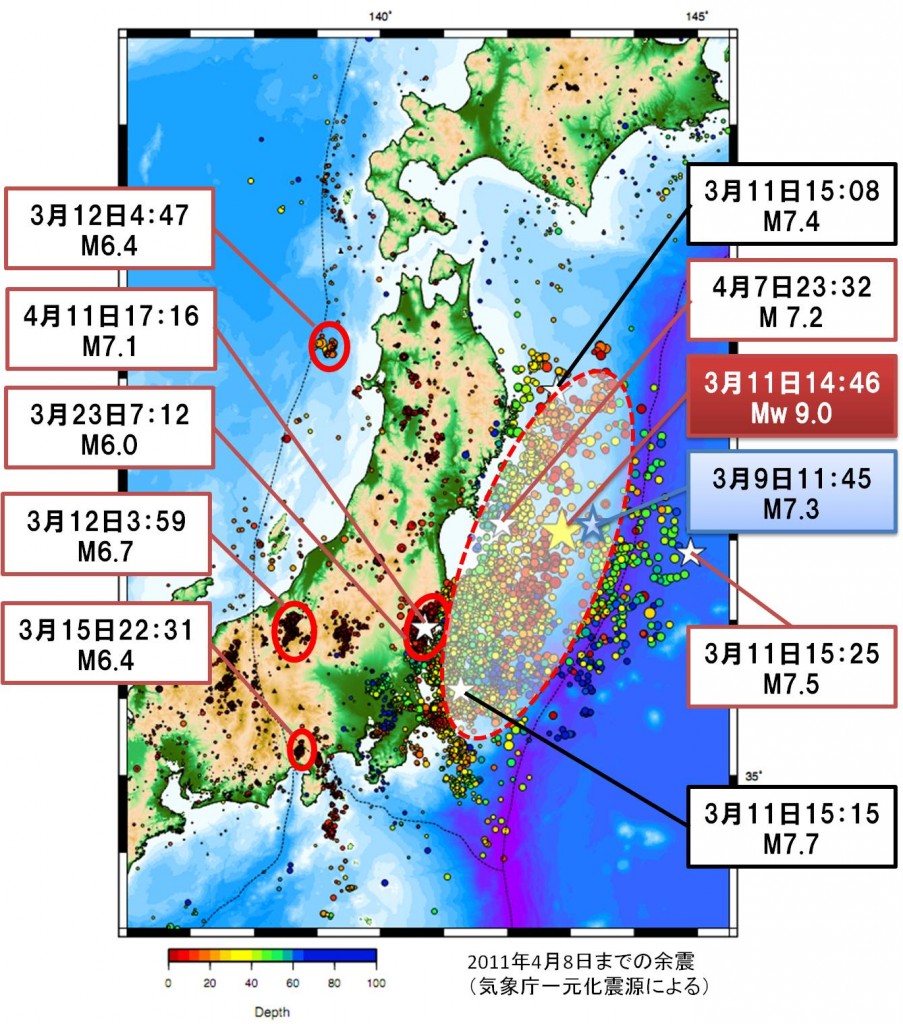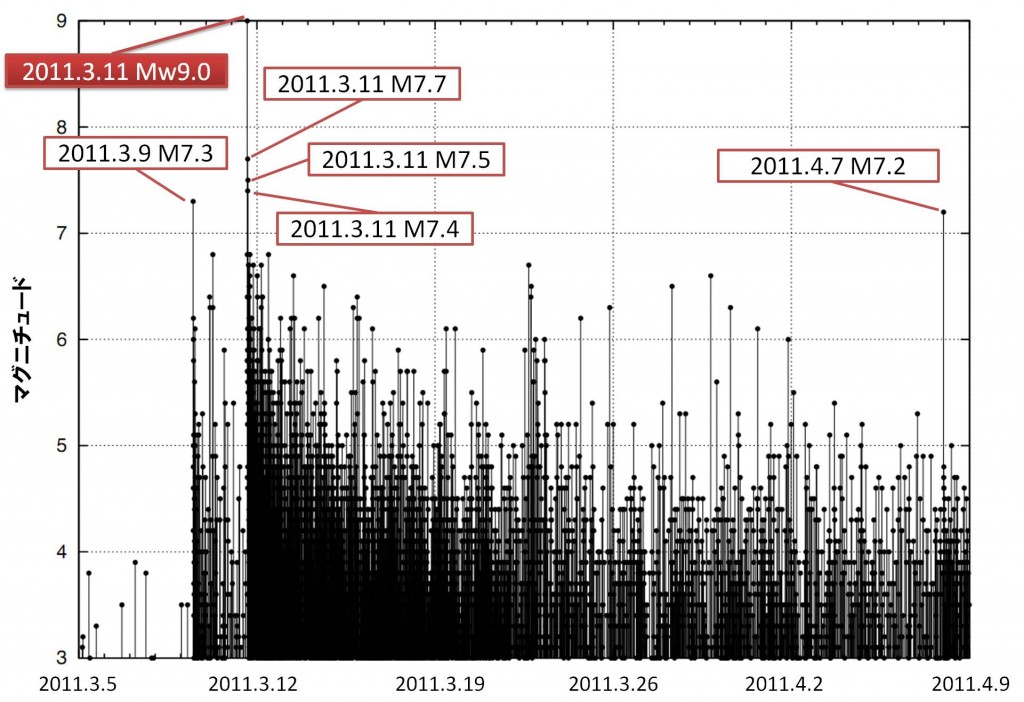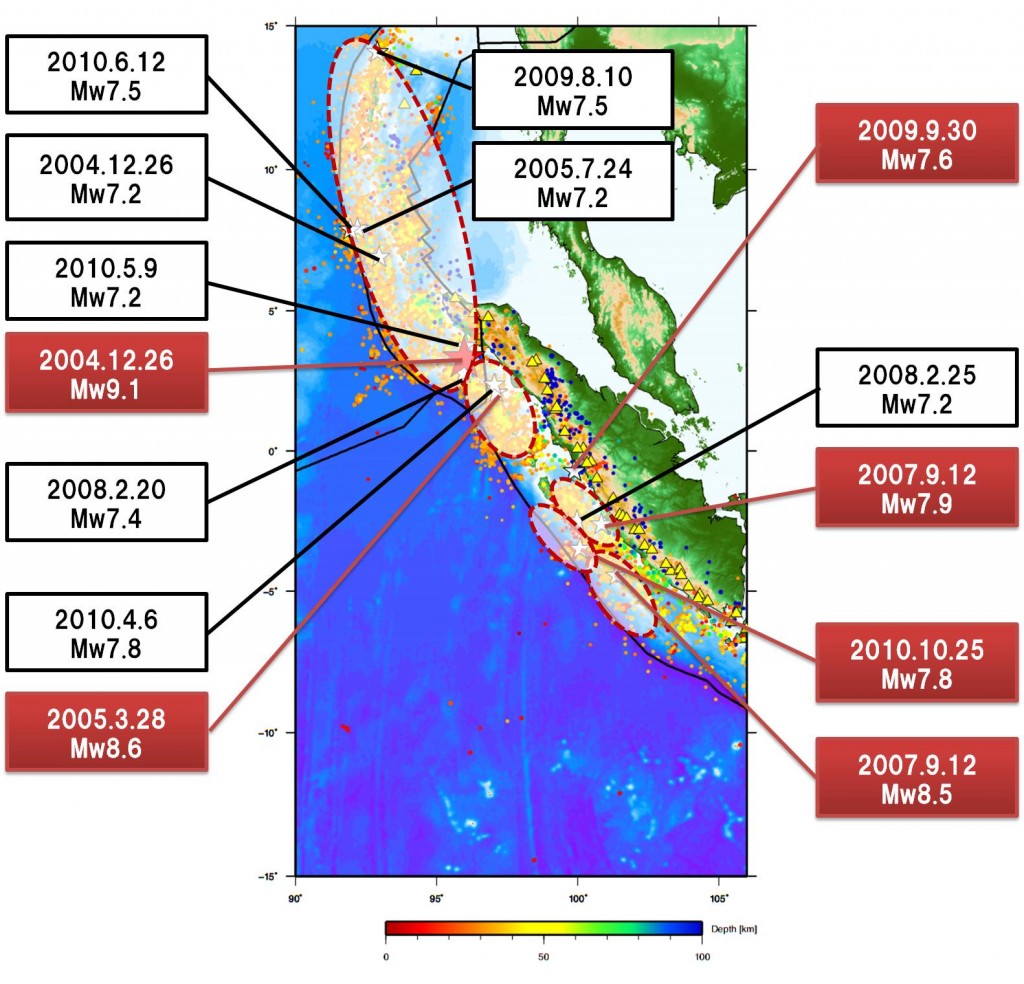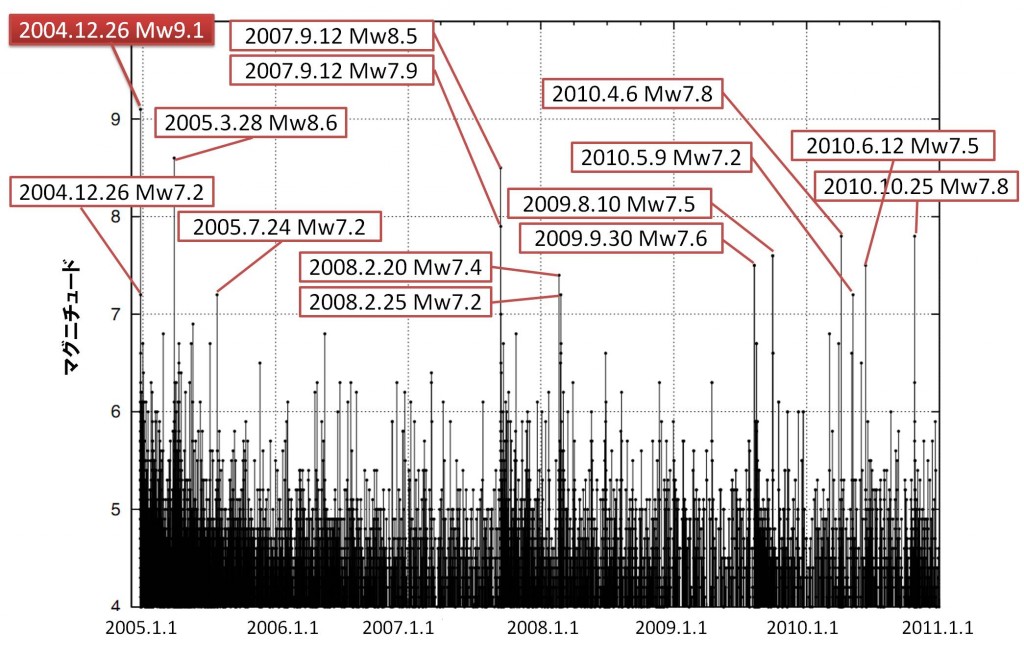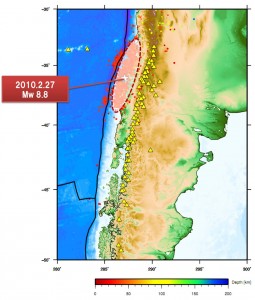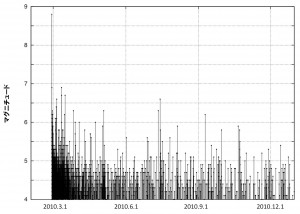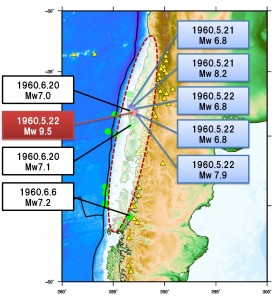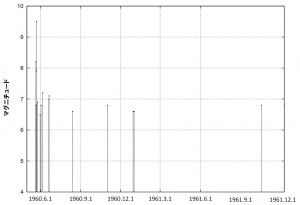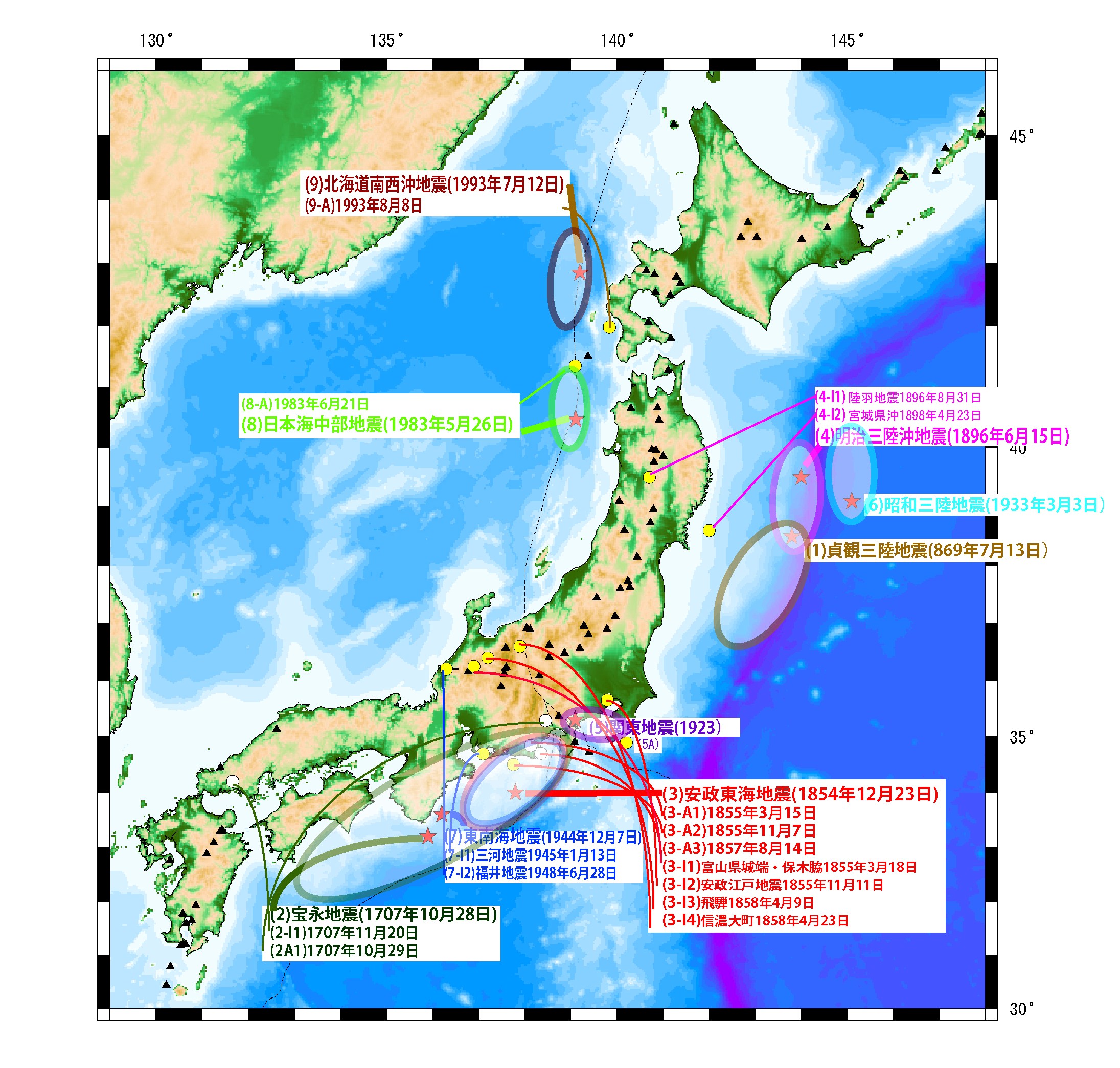Aftershocks of the past massive earthquakes
Aftershocks will always occur after a huge earthquake. Attention to the aftershocks has to be paid in a long-term for this earthquake with magnitude of 9.
Therefore, as a reference, below is the summary of the magnitude of aftershocks and the occurrence time of examples from off Sumatra earthquake in 2004, 2010 Chile earthquake and 1960 great Chilean earthquake. Additionally, the example of historical earthquakes within Japan is also given. (Click here to see the map indicating the historical earthquakes).
(By: Dr.Oki, Dr.Tsuji, Dr. Nishida)
The figure below shows the date and time in horizontal axis and magnitude in vertical axis. The red text box is the main shock, and the other text boxes are the earthquakes above M7 that occurred after 5th March. (The text box color is not implying anything)
Secondly, below figure is the example of Sumatra-Andaman Islands Earthquake in December 2004 (according to the USGS PDE catalogue till December 2010). The red text boxes are main shocks, and the black text boxes are aftershocks, but it is not necessary the case that there is always a main shock and aftershock relation. In the focal region of the mainshock with Mw9.1, there are 6 aftershocks above M7.
The most recent one is M7.2 in May 2010, which is five and a half years after the mainshock. There was an argument weather to take the Mw8.6 earthquake in March 2005 as a largest aftershock of Sumatra-Andaman Islands Earthquake in December 2004 or to consider it as another earthquake. Here, it is considered as another earthquake and indicated in red, but it is undeniable that this was triggered by the earthquake in 2004. As mentioned above, there may be a various remarks concerning the red text boxes and the black, but for now, the purpose of this figure is to show the earthquake activities around Sumatra, so we will not go into further discussion in detail.
Below is the MT diagram.
Following is the aftershock distribution of Central Chilean Earthquake in February 2010 (according to the USGS PDE catalogue till December 2010). No aftershocks larger than M7 have occurred despite the fact that the earthquake was massive with Mw8.8.
Additionally, below is the aftershock distribution of 1960 Great Chilean earthquake with limited data. There were 5 foreshocks (blue text box) with over M6.8 to M8 that lead to the main shock of Mw9.5. The aftershocks over M7 were just three.
Finally, below is the summary of earthquake activities in historical earthquakes of Japan. Here, aftershocks in narrow sense are named “notable aftershock” and the earthquakes triggered by the main shock are named “induced earthquake” (I, induced), but there may be a various perspectives in which earthquakes were induced. (Click here to see the map indicating the historical earthquakes).
1. Induced earthquake of 869 Jogan Sanriku earthquake and tsunami
“The 878 (Gangyo 2nd year) Kanto earthquake” that occurred 10 years after 869 (Jogan 11th year) Sanriku earthquake(M≒8.3)is assumed to be caused by the slip of Isehara fault (Usami 1996). According to the Chronological Scientific Tables, “The ground shake lasted for 5 to 6 days and especially, Sagami and Musashi were destroyed badly. There was not even one building (private nor public property) without destruction. The roads were collapsed and transportation was blocked. Many were crushed to death”. This earthquake could be said as an earthquake directly under the city center, and may be understood as “induced earthquake”. But 10years of interval is too long to define as an induced earthquake.
2. Notable aftershocks and induced earthquakes of 1707 Hoei earthquake
The Hoei earthquake (M8.6, 14:00 28th October 1707) is considered to be the coupled massive earthquake which hypocenter in off Tokai and off Nankai slipped at the same time.
(2-A)Notable aftershocks of Hoei earthquake
A1 . 16 hours after the main shock of Hoei earthquake: the next day (06:00 29th October 1707), there was an earthquake with hypocenter in the mid watershed area of Fuji river, and destruction of temples and death were found in Kofu-bonchi, Fujinomiya, and Shizuoka where none died in main shock.
A2.13th February 1708, 3 months after the main shock, a largest shake since the main shock reached Kyoto, and a tsunami was recorded in Iseyamada (Ise city in Mie pref.) and Nankai city in Wakayama pref. This must be the largest aftershock of the Hoei earthquake.
(2-I)Induced earthquake of the Hoei earthquake
I1.23 days after the main shock of Hoei earthquake, there occurred a local earthquake causing collapse of 189 houses and 3 death tolls in Nagatonokuni Sabagun Kamitokuchi village (present: Tokuchi, Yamaguchi city).
I2.1714 : 7 years after the main shock of Hoei earthquake, there was an induced earthquake (M6 lower) near ShinanoOtari-mura (Northern Oomachi, Shiroumacho).
3. Notable aftershocks and induced earthquakes of 1854 Ansei-Tōkai earthquake
Ansei-Tōkai earthquake (M8.4 23rd December 1854) is a so called coupled earthquake of Tokai earthquake and Tonannkai earthquake. The damage extended from Kanto to Kinki and tsunami hit the coast of Boso to Tosa.
(3-A)Notable aftershock of Ansei-Tōkai earthquake
A1. 15th March 1855: 70days after Ansei-Tōkai earthquake, an earthquake caused the liquefaction in Yaezua and levee shake in lower reach of an Ooigawa river.
A2. 7th November 1855, 10 months after the main shock, a M7.0-M7.5 aftershock occurred with hypocenter in Enshu-nada, having tsunami and destruction of houses. This is considered as the largest aftershock of Ansei-Tōkai earthquake.
A3. 14th August 1857, after three and a half years from main shock occurred earthquake (M6 lower) in Surugawan. The stone walled stores fell in Tanaka-jou Suruganokuni (Fujieda city), and also some destructions in Shizuoka and Sagara.
(3-I)Induced earthquake of Ansei-Tōkai earthquake
I1. 18th March 1855, 75 days after Ansei-Tōkai earthquake, a M6 earthquake occurred in Johana-machi, Hokiwaki in Toyama pref.
I2. “The Ansei Edo earthquake”(M7.0~7.1)occurred 11 months after Ansei-Tōkai earthquake could be considered as an induced earthquake of the Ansei-Tōkai earthquake.
I3. “Hietsu earthquake” (M7.0~7.1)occurred on 26th February 1858, after four and a half years from Ansei-Tōkai earthquake. 203 death toll in Hietsu, and upper part of Jouganji river was blocked and bursted later adding 140 to the death toll. This earthquake is said to be caused by the activity of Atotsugawa fault.
I4. Shinano Omachi Eathquake(M5.7)occurred on 10th March 1858, four and a half years after Ansei-Tōkai earthquake. It is extremely close to the earthquake location of the above-mentioned induced earthquake of the Hoei earthquake.
4. Induced earthquake of 1896 Meiji-Sanriku earthquake
No damage was caused by the lower M8 earthquake on 15th June 1896 at off-Iwate. No damage by the shake of the earthquake but tsunami hit the coast from Hokkaido to Oga peninsula, killing more than 20 thousand people in Hokkaido, Aomori, Iwate and Miyagi. Tsunami height recorded in Ryori was 38.2m, and 14.6m in Tarou.
I1. Rikuu earthquake(M7.2)occurred 2months after the Meiji-Sanriku earthquake (15th June 1896) in the border between Iwate and Akita prefectures. Death toll in Akita is 205 and 4 in Iwate.
I2. Off- Miyagi earthquake(M7.2)occurred on 23rd April 1898, 1 and 10 months after Meiji-Sanriku earthquake. This caused a small destruction in Kmaishi, Sendai plain and Ishinomaki, with a small tsunami. The focal region of this earthquake is closer toward land than of the Meiji-Sanriku earthquake, and both are not overlapping. Therefore it is considered to be an induced earthquake and not aftershock.
5. Aftershock of 1923 Great Kantō earthquake
6 large aftershocks were found for Great Kantō earthquake. After M7.9 main shock on 11:46 1st September 1923, there was an aftershock of M7.2 at 12:01, M7.3 at 12:03 and M7.1 at 12:48. Further, on the next day, 2nd September 11:46 was a M7.6 aftershock and M7.1 18:27 on the same day. Then 15th January 1924, aftershock of M7.3 occurred.
Each of the aftershocks are as large as or larger than the Great Hanshin earthquake.
6.Induced earthquake of the 1933 Sanriku earthquake
3rd March 1933, normal fault type massive earthquake occurred near Japan trench with M8.1, and tsunami hit the pacific coast. This is what is called a outer rise earthquake. Death toll and missing people are more than 3000, and the wave height reached 28.7m at Ryori bay. No induced earthquake was found in this earthquake.
7. Induced earthquake of the Tonankai earthquake (1944)
The Tonankai earthquake(M7.91944) is considered to be one of the Tokai earthquake occurred in the coastal water body of Mie prefecture to off-Enshu. Other than the death toll and missing 1223, and far in the Nagano-bonchi, 12 houses were completely destroyed. Tsunami hit each areas with estimated height: 6-8m at Kumano-nada coast and 1-2m Enshu-nada coast. Ground sank 30-40cm at East coast of Kii Peninsula.
I1. 47 days after Tonankai earthquake (1944), “Mikawa earthquake”(M6.8)occurred on 13th January 1945, having hypocenter in the west of Gamagoori-city in Aichi prefecture. Death toll was 2306 which is more than the number in Tonankai earthquake(1223 dead).
I2. Four and a half years after the main shock, M7.1 earthquake occurred at Reihoku area in Fukui prefecture (“Fukui earthquake”) on 28th June 1948 and death toll was above 3000.
8.The largest aftershock of the Nihonkaichubu earthquake(1983)
26th May 1983, M7.7 earthquake occurred at Akita prefecture and more than hundred was killed by tsunami. On the area connected with the north of mainshock, largest aftershock with small tsunami occurred on 21st June, 25days after the main shock.
9. The largest aftershock of 1993 southwest-off Hokkaido earthquake
Huge damage was caused by tsunami and shake with M8.2 earthquake occurred 22:00 on 12th July 1993. The largest aftershock occurred on 8th August which is 27 days after the main shock.

